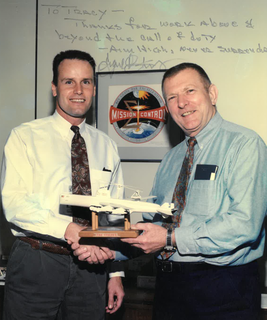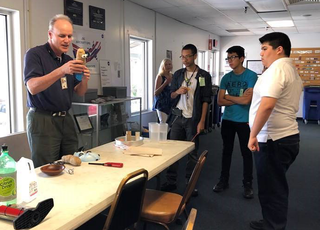Rocketing to Success
Beacon Stories
Tracy was the fourth generation of his family to receive the diagnosis of retinitis pigmentosa, but he never let that stop him from dreaming big. Tracy has worked at NASA’s Johnson Space Center for over 36 years, making significant contributions over the many years.
Tracy Minish was raised in a town outside of Athens, Georgia, and diagnosed with retinitis pigmentosa (RP) while in high school. Becoming the fourth generation of his family to get this diagnosis, his great grandmother, grandmother, and mother also having RP, this news didn’t come as a complete shock to him. Now there are five generations of Minish family members with RP, including his son.
At 64 years old, Tracy has less than 5% of his field of vision left. But after receiving genetic testing, he is very optimistic for a future cure for his family.
“We now have a grand baby, and if he turns out to have RP, I am confident there will be a cure before he’s a teenager,” says Tracy. Because of genetic testing, Tracy knows he has RP with genetic mutations in the PRPF-31 gene, and strongly encourages people with genetic eye diseases to seek testing.
“A lot of amazing research is happening now, but if you do not know your specific genetic mutation, you can’t participate in the research to find the cure,” says Tracy. “It’s important to have genetic testing in order to pinpoint exactly what is causing your disease.”

Tracy with legendary NASA Chief Flight Director Gene Kranz.
Tracy has always had a positive attitude toward the future. Growing up, Tracy loved math and knew he wanted to attend college but had to work his way through to pay for classes. His college counselor highly discouraged him from pursuing a degree in science or engineering due to his eyesight limitations. Instead of changing degrees, he changed counselors and ended up graduating from the University of Georgia with a Bachelor of Science in computer science.
Just as Tracy was graduating, a NASA contractor came to the University to hire a software engineer for the shuttle simulators used to train astronauts. Tracy interviewed for the position, got offered the job, and flew on a plane for the first time to move to Houston, Texas, with his wife, Sherry. Tracy has now worked at NASA’s Johnson Space Center for over 36 years, making significant contributions over the many years.
“I can’t imagine the life I would have had if I had listened to that counselor,” says Tracy. “Times have changed now thankfully, but I don’t want anyone in this generation to think they can’t dream big.”
Tracy spent his first two years at NASA writing software programs for the shuttle simulator, and the next 13 years as a shuttle instructor, training astronauts and flight controllers on shuttle payloads, shuttle computers, and even worked on the first Hubble Space Telescope.
In 1998, Tracy transferred over to NASA to work on shuttle and space station flight software (FSW) and reconfiguration data, becoming the FSW/Recon Branch Chief. Then in 2004, Tracy told his division chief he wanted to change roles to try something different and was assigned as chair of the Ground Segment Control Board, making him responsible for defining international partners' control center requirements and interfaces. Despite being legally blind, Tracy traveled around the world for this role to places like Moscow, Tokyo, Toulouse, Montreal, and more.
One night, after a very long trip to Moscow, Tracy accidentally locked himself outside his room with only his fruit-of-the-looms/tighty-whities. Having very little eyesight made it an adventure to traverse the obstacle course of the old building to get to the front desk for a key and back to his room. Tracy laughs when telling this story saying, “I consider this one of my most successful missions by not getting arrested and thrown into a Russian jail. I now wear only boxers and never move about my room without my cell phone.”
Tracy is currently the Mission Control Center Operations Manager, meaning he is on call 24/7 if there’s an issue on the ground. Tracy played a role in the recent success of the SpaceX Demo-2 mission where NASA astronauts launched in American built rockets, from American soil. He is also proud to be a part of the Artemis program where the first woman will put boots on the Moon by 2024.
Tracy also previously served as the chair of the No Boundaries Employee Resource Group at NASA, helping individuals with disabilities, and now leads their outreach programs.
This past year, NASA celebrated the 50th anniversary of Apollo 11 and Neil Armstrong landing on the Moon. “As great a man as Neil Armstrong was, NASA could not have landed a man on the Moon and returned him safely if we had filled NASA with clones of Neil Armstrong,” recalls Tracy. “It took diversity of thought, different perspectives, and unique problem-solving skills to meet the challenge. Cloning is overrated, diversity and inclusion are underrated, but the times they are a changin’.”
When Tracy first started working at NASA, he recalls struggling with self-identifying and being open with his coworkers about his vision loss. His “tricks” of memorizing everything around him only worked for so long, and he got to a point where he realized he needed to tell those around him that he was legally blind.
“I would fast and drink no liquids the night before long flight readiness review meetings, just so I wouldn’t have to stumble around in the dimly lit conference room if I needed to take a break,” recalls Tracy. “Once I self-identified, my work-life became much easier and my teammates were awesome.”
With the assistive-technology tools NASA has provided, Tracy manages his emails, reviews documents, creates presentations, and more, without any assistance. His division even has a chair in their large conference room that is known to always be Tracy’s chair, sort of an unspoken rule, but makes it a lot easier for him to know where to go in a room in which he can’t see well.

Tracy demonstrating science experiments to group of students from Texas Workforce Commission.
“Employers, and society in general, are unaware that many of the limitations associated with disabilities are no longer boundaries,” says Tracy. “My teammates at NASA have always been so generous to me and have given me so many opportunities. These opportunities, combined with assistive technologies, have allowed me to be the most productive and accomplished person I can be.”
Tracy’s dedicated work ethic to succeed translates to his personal life as well. Distance running is Tracy’s favorite way to stay mentally and physically fit, having completed 31 full marathons to date. Tracy ran solo for a while, but after falling in a race six times, he realized running alone was no longer a safe option for him or the runners around him. Tracy didn’t want to just run on a treadmill, so he stopped running for about five years. But in 2011, he decided to reach out to the Houston Marathon, and they assigned him a running guide. From that point on, he has trained and raced with a guide, and in 2012, Tracy qualified and ran in the Boston Marathon in record heat and is still running strong today.
At the end of 2021, Tracy is planning to retire from NASA, but wants to continue “working” by traveling to schools and other various events as a speaker to use his vision loss as a platform to teach others about disabilities and diversity.
“I want to inspire young people to reach their full potential,” says Tracy. “I used to look at my RP as a weakness, but I’ve learned that there are very few limits I have because of my vision loss. Take what you love and figure out a way to do it; concentrate on what you can do and not what you can’t do.”
Tracy has always been inspired by Dr. Martin Luther King Jr.’s famous “I Have a Dream” speech and strongly believes all kids have the right to dream, and society has the responsibility to provide the training and tools to allow them to chase down their dreams.
“We all, including myself, need to give more, serve more, live more, and love more,” says Tracy. “Failure is not an option.”




